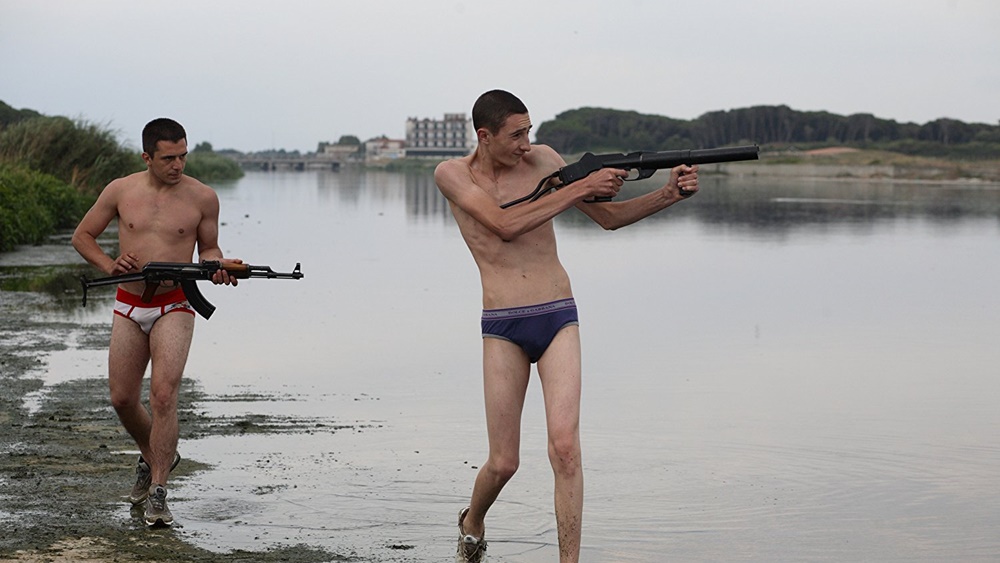Brutal and uncompromising take on the Italian mafia, shot with raw realism by rising director Matteo Garrone.
Dir. Matteo Garrone
2008 | Italy | Crime/Drama | 137 mins | 2.35:1 | Neapolitan & Italian
M18 (passed clean) for strong violence and some sexuality
Cast: Gianfelice Imparato, Salvatore Abruzzese, Toni Servillo
Plot: A Neapolitan mob drama that exposes Italy’s criminal underbelly by telling five stories of individuals who think they can make their own pact with Camorra, the area’s Mafia.
Awards: Won Grand Prize of the Jury (Cannes); Nom. for Best Foreign Language Film (Golden Globes)
International Sales: Fandango Portobello
Accessibility Index
Subject Matter: Heavy/Violent
Narrative Style: Complex
Pace: Slightly Slow
Audience Type: Slightly Arthouse

(Reviewed at Italian Film Festival – first published 28 Mar 2012)
Spoilers: Mild
Martin Scorsese was so impressed by Gomorrah that he lent his name to market the film, allowing it to extend its reach to a wider audience. Directed by Matteo Garrone, Gomorrah is a harrowing motion picture about organized crime in Italy.
It is based on a book by Roberto Saviano, whose undercover work within the Camorra has led him to expose the secret illegal activities of the brutal Mafia-esque organization, and whose life is now at stake because of his work.
Winning the Grand Jury Prize at Cannes and earning Italy a Best Foreign Film Golden Globe nomination, Gomorrah unfortunately did not meet the cut for the Oscars.
Gomorrah is a unique film of the crime genre (and the gangster subgenre). Even then, comparisons with Francis Ford Coppola’s The Godfather trilogy and Scorsese’s own Goodfellas (1990) are bound to happen; but they do not amount to anything more than just conversations in passing, because Gomorrah neither romanticizes (as in the former) nor dissects the inner workings (as in the latter) of organized crime.
Roberto Saviano got death threats from the Camorra for exposing their activities in the novel and movie, and is now permanently under police protection.
Rather, Garrone’s film seeks to reflect organized crime as it is in reality in Italy – rampant, ungovernable, and shockingly, ordinary. Shot on location in Naples, Gomorrah is gritty, raw, almost documentary-like, plus all the brutal violence which normally ensues a life of crime, and that would never have been captured in a real documentary.
This is gangsterism at the street level; not once do we see a group of kingpins masterminding kills or drawing up plans to steal drugs, weapons, or whatever these bastards do to gratify themselves. The common man is born into a culture of crime, seeking alliance (and protection) from the side which gives the best monetary rewards.
Garrone splits his film into five interrelated narrative threads, each focusing on one or two characters, and their extent of affiliation toward the Camorra. In one disturbing sequence, two teenage boys find loaded weapons and celebrate by shooting into the distance on an isolated beach.
Such is the mentality that gangsterism is a way of life that they seek to emulate the power and control that comes with being one. Some of them obviously know a thing or two about this with passing references to Brian De Palma’s Scarface (1983).
These people whom are trapped in the vicious cycle of poverty and violence are mere pawns in an ever evolving game of trust and mistrust. They will never reach the top ala Tony Montana; they are killed once their ‘mission’ is complete or if they screw up on their job.
Matteo Garrone lived for two months in the infamous Neapolitan quarter Scampia before making the movie.
Either way they are condemned to die. The chilling thing is that they have no choice. What is even more chilling lies in their ‘chronic myopia’, their inability (or disability) to understand how the ‘system’ they work for works.
Gomorrah is a difficult film to watch because of its subject matter. Its realism is unsettling, and the violence uncompromising and sudden. Garrone understands this ‘suddenness’ and invites us to participate in a couple of scenes (no one is safe, even in a moving car) that illustrate the mindless spontaneity of it all.
Occasionally, it gets less interesting during lengthy uneventful dialogue-driven sequences, but it seeks to create suspense even when there should be none.
Gomorrah is not a film one would revisit time and again, but its lasting legacy is its ability to invoke non-action as encapsulated in the final shot of a bulldozer carrying two dead bodies into the dark distance. After all, this is a bleak wheel that turns and turns forever.
Grade: A-
Trailer:
Music:












[…] to the gritty filmmaking style that characterised his international breakthrough Gomorrah (2008), Dogman is a menacing work depicting a bleak society and selfish characters, yet within this […]
LikeLike